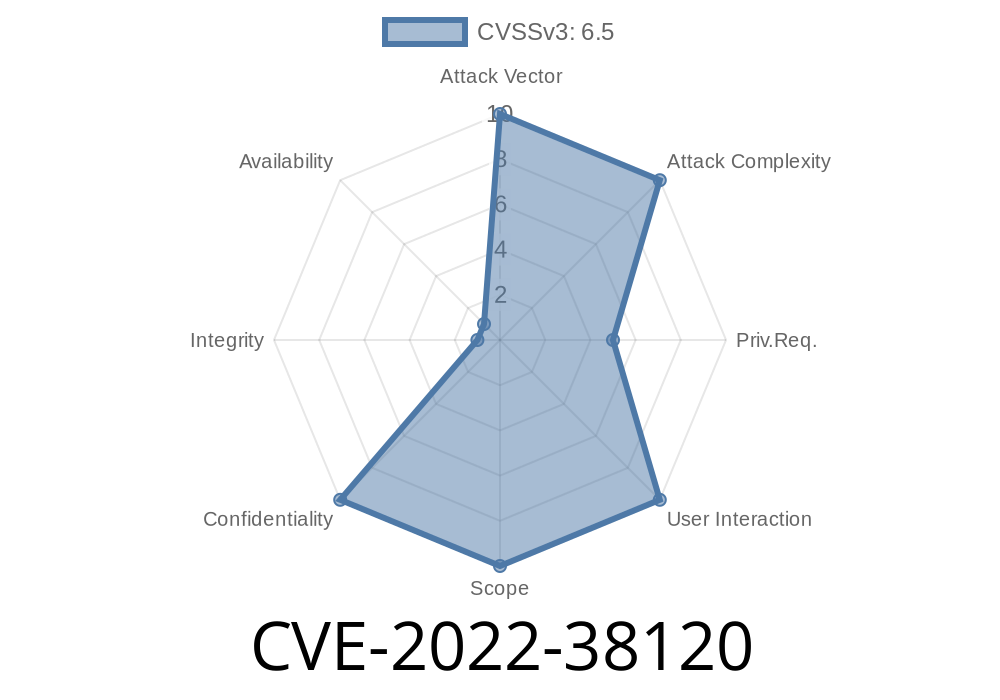CVE-2022-38120 is a security vulnerability identified in the UPSMON PRO software, specifically a path traversal vulnerability. UPSMON PRO is a popular monitoring tool used by many organizations to manage and monitor their Uninterruptible Power Supply (UPS) systems. This post aims to shed light on the vulnerability, the potential risks it poses, and how a remote attacker with general user privilege could exploit it. We'll also provide code snippets, links to the original references, and discuss how to mitigate the risks associated with this vulnerability.
Vulnerability Details
A path traversal vulnerability, also known as directory traversal, allows an attacker to access arbitrary system files or directories that should be inaccessible in normal circumstances. In the case of CVE-2022-38120, a remote attacker with general user privilege is capable of exploiting this vulnerability to bypass authentication and gain unauthorized access to sensitive system files.
The vulnerability exists due to insufficient validation of user-supplied input in the filepath parameter of the UPSMON PRO software. An attacker could potentially manipulate this parameter to access files outside the intended directory, ultimately granting unauthorized access to sensitive information.
Exploit Details
To exploit this vulnerability, an attacker would send a specially crafted HTTP request to the UPSMON PRO server, which includes a malicious filepath parameter. This request could look something like this:
GET /upc_download.asp?FILE=../../../../../etc/passwd HTTP/1.1
Host: <target_IP_address>:<port>
In the example above, the attacker manipulates the FILE parameter to traverse directories and target the /etc/passwd file, which contains critical user information such as usernames and hashed passwords. This file is an example of data that should not be accessible to a remote general user.
Original References
This vulnerability was first reported on the Zero Day Initiative by an independent security researcher. Since then, multiple sources have published their findings on this issue, providing more details and context to the public.
1. Zero Day Initiative Advisory: ZDI-CAN-12105
2. NIST National Vulnerability Database: CVE-2022-38120
3. Exploit Database (Exploit-DB): CVE-2022-38120 - UPSMON PRO Path Traversal Vulnerability
Mitigating the Risk
To reduce the risks associated with this vulnerability, administrators of UPS systems utilizing UPSMON PRO should consider the following steps:
1. Apply available security patches as soon as possible. Always ensure that the software is up-to-date with the latest security patches. You can check the software vendor's website for the most recent updates and instructions on how to install them.
2. Implement network-level access control and segmentation. By restricting access to the UPSMON PRO server only to authorized IPs and networks, the potential impact of an exploit is greatly reduced.
3. Regularly review and monitor access logs. This helps detect any unauthorized attempts to access the server or manipulate the vulnerable filepath parameter.
4. Maintain strong password policies. Regularly changing passwords and using strong, complex passwords reduces the chances of an attacker gaining unauthorized access.
Conclusion
In conclusion, CVE-2022-38120 is a serious path traversal vulnerability in the UPSMON PRO software, allowing remote attackers with general user privileges to bypass authentication and access sensitive system files. It's essential for organizations relying on UPSMON PRO to be aware of this vulnerability and actively take steps to mitigate the risks associated with it. By staying informed and implementing proper security measures, organizations can better protect their critical systems and data against such vulnerabilities.
Timeline
Published on: 11/10/2022 15:15:00 UTC
Last modified on: 11/10/2022 15:22:00 UTC
